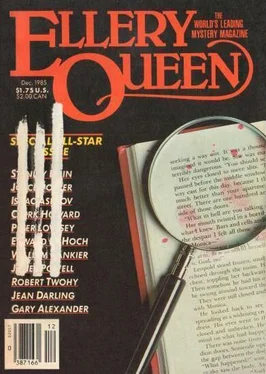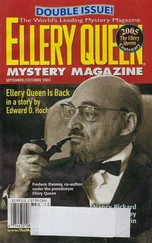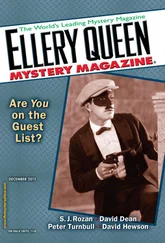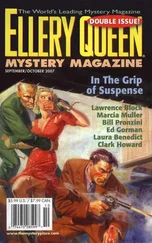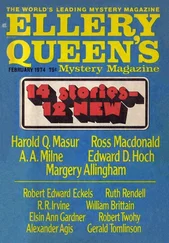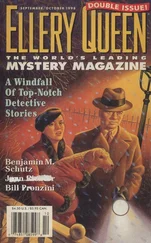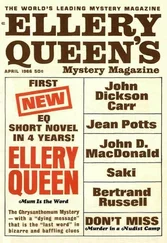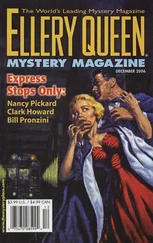Gary Alexander - Ellery Queen's Mystery Magazine, Vol. 86, No. 6. Whole No. 511, December 1985
Здесь есть возможность читать онлайн «Gary Alexander - Ellery Queen's Mystery Magazine, Vol. 86, No. 6. Whole No. 511, December 1985» весь текст электронной книги совершенно бесплатно (целиком полную версию без сокращений). В некоторых случаях можно слушать аудио, скачать через торрент в формате fb2 и присутствует краткое содержание. Город: New York, Год выпуска: 1985, Издательство: Davis Publications, Жанр: Детектив, на английском языке. Описание произведения, (предисловие) а так же отзывы посетителей доступны на портале библиотеки ЛибКат.
- Название:Ellery Queen's Mystery Magazine, Vol. 86, No. 6. Whole No. 511, December 1985
- Автор:
- Издательство:Davis Publications
- Жанр:
- Год:1985
- Город:New York
- ISBN:нет данных
- Рейтинг книги:5 / 5. Голосов: 1
-
Избранное:Добавить в избранное
- Отзывы:
-
Ваша оценка:
- 100
- 1
- 2
- 3
- 4
- 5
Ellery Queen's Mystery Magazine, Vol. 86, No. 6. Whole No. 511, December 1985: краткое содержание, описание и аннотация
Предлагаем к чтению аннотацию, описание, краткое содержание или предисловие (зависит от того, что написал сам автор книги «Ellery Queen's Mystery Magazine, Vol. 86, No. 6. Whole No. 511, December 1985»). Если вы не нашли необходимую информацию о книге — напишите в комментариях, мы постараемся отыскать её.
Ellery Queen's Mystery Magazine, Vol. 86, No. 6. Whole No. 511, December 1985 — читать онлайн бесплатно полную книгу (весь текст) целиком
Ниже представлен текст книги, разбитый по страницам. Система сохранения места последней прочитанной страницы, позволяет с удобством читать онлайн бесплатно книгу «Ellery Queen's Mystery Magazine, Vol. 86, No. 6. Whole No. 511, December 1985», без необходимости каждый раз заново искать на чём Вы остановились. Поставьте закладку, и сможете в любой момент перейти на страницу, на которой закончили чтение.
Интервал:
Закладка:
She stared at him, unable to find words.
He replaced his sunglasses. “I think I’d better leave. All I can say is that you must have hated that sister of yours.” He started toward the door.
Miss Parmenter still had the vase in her hands. She lifted it high and crashed it onto the back of Mr. Yarrow’s skull.
He fell without a sound. Blood flowed across the rosewood table, coloring the splinters of stoneware scattered over its surface.
She went to the cupboard in the kitchen where she kept her sleeping tablets. She swallowed two handfuls and washed them down with water.
Then she went into the room where the pots were ranged on shelves. She opened the window and started dropping them slowly into the courtyard among the empty beercans.
The bridge of traded dreams
by James Powell [9] © 1985 by James Powell.
Europe will long remember the dream mania of 1869. The year opened with the publication of Charcot’s brilliant Dream Baedecker , which guided an entire generation through the terra incognita of the Land of Nod. And it closed with the final curtain descending on Scalamandre’s much unappreciated ballet “The Haunted Bird of Sleep.” In between, in every household or boulevard café, the day’s first order of business was the telling of one’s adventures in the valley of slumber the night before. When Europe finally did get around to unfolding its morning newspapers, it was to read of the dreams of the famous.
In Paris, plush perfumed dreameries sprang up, sumptuous rentable alcoves for afternoon naps. In Milan, the dictators of fashion plundered the bed chamber to send the well dressed into the streets like sleepwalkers in pajamalike suits and nightgownlike gowns. In Stockholm, a political party called the Night Caps sprang to the fore, while London’s Harley Street spun out a whole new school of premonitory medicine using dream interpretation based on one brief sentence in Hobbes’ Leviathan. (“And seeing dreams are caused by the distemper of the inward parts of the Body, divers distempers must needs cause different Dreams.”)
In San Sebastiano. the great detective Ambrose Ganelon threw his famous jaundiced eye on the craze only long enough to determine that his nemesis, the evil genius Dr. Ludwig Fong, was not behind it. He did not consider the dream mania again until June when Felicien de Prattmann arrived back in the Principality.
Prattmann (the “de” was affectation) had begun the year as a ghost dreamer, inventing imaginative dreams for the dull to recount as their own. But he quickly won a reputation throughout Europe as a dream dowser, one who uses people’s night phantasms to help them discover lost articles or hidden treasure. Nor was he reluctant to demand his rightful share of recovered valuables. Once, the story goes, he urged a client who dreamed of an egg buried beneath a certain tree to dig there. The man discovered a lost trove of silver and gold. But when he brought some of the silver to Prattmann as a reward, the dream dowser was not above remarking that he’d like a bit of the yolk as well.
A descendant of Marc-Antoine Prattmann, the greatest of all makers of woodwind instruments, the dream dowser inherited a masterwork of an oboe known to the musical world as the Black Emperor. Ganelon desired above all else to possess this instrument, which as a family heirloom was not for sale. But young Prattmann had a weakness. He was an avid collector of baroque eggcups of the Wurtemburger school. Ganelon was sure Prattmann would trade the oboe for the two remaining eggcups of the famous Ravenburg set, which had been scattered across Europe during the Napoleonic Wars. Using his staff of operatives, Ganelon found and purchased one of the cups and picked up a trail that led to its mate. But his people arrived at the small Marseilles antique shop a day after the second cup was purchased by an Englishman, a professor of mathematics, on a vacation walking tour. “Damnable eaters of soft-boiled eggs, the English!” Ganelon had raged. But on reflection, he decided one eggcup might be sufficient if he played his man well.
Now Madame, as everyone called Madame Ganelon, was constantly urging him to invite people to share their table. For his part, Ganelon held that if one was going to fill one’s dining room with strangers one might as well eat out. And he seldom cared to eat out. But in this case he decided he needed the help of Madame’s excellent cooking. He opened his Prattmann campaign by inviting the young man to dinner.
Unfortunately, Prattmann interpreted this to mean Ganelon was interested in dreams. He rattled on about his work, much too full of himself to realize that Ganelon preferred to dominate the talk at his own table. By the end of the meal, the host’s pasted smile had gone awry and Madame was happy to flee the table to leave them to brandy and cigars.
As Prattmann ended a long description of Egyptian dream lore and a particular belief under the pharoahs that a dream could be transmitted into a sleeper’s mind by writing it out and feeding the papyrus to a cat, Ganelon began to savor the immediate pleasure of throwing the young man down the stairs. But then Prattmann said, “Personally, I believe some dreams are clews leading back to deep, forgotten, or perhaps even repressed memories. Whatever it is I help a client find, whether treasure, deed, or will, he already knows where it is. But he doesn’t know he knows. As a very young child, he may have heard a parent or a grandparent speak of buried valuables. Or seen someone hide something behind a sliding panel. Or slip something into a book to mark a place. I believe a dream is memory trying to force its way to the surface again.”
Ganelon grunted. Surely that was the most intelligent thing the young man had said all night.
“But my theory has been shaken by a recent client,” said Prattmann. “May I tell you about his dream?”
Ganelon scowled through his cigar smoke, suspecting he was being led into a trap, but he signaled permission.
“On a recent trip to London, I had among my clients a straightforward-looking fellow in his fifties named Swaffham, who told me quite an extraordinary dream,” said Prattmann. “The man found himself standing at one end of a stone bridge of the Gothic style thrown across a river that divided a crowded city. The bridge was lined on either side with a jumble of small two- or three-story shops of the same material which overhung a narrow passageway busy with people in costumes of another time. He suspected they were not English. As he stood watching this scene, a voice said, ‘Return here at high noon until you learn something to your profit.’ So compelling was this dream that he would have obeyed it on waking, but neither he nor his friends knew where such a bridge existed.” Prattmann laughed.
“And of course you told him he was describing our own Bridge Saint Eloi,” said Ganelon. For centuries the shops on the bridge sheltered the Principality’s sword- and knife-making guilds and related crafts. In recent years the trade was mostly in souvenir letter-openers and novelty pocket knives.
“But here’s the amazing thing,” said Prattmann. “He’d never in his life visited San Sebastiano.”
Ganelon shrugged. “I wager his dream was in black and white, and he saw the bridge from the vantage of the southwest corner through Traitor’s Gate.” This was the ancient bridge gate where once were displayed the severed heads of those executed for treason.
When the bewildered Prattmann acknowledged this, Ganelon said. “Then perhaps your original explanation will serve, after all. I suggest that without realizing it. your man was remembering that etching Banville did for Babelon’s novel The Master Scabbard-Maker s Daughter.” In the first quarter of the Nineteenth Century, Joseph-Marie Babelon (1775–1833) had placed the Principality in the forefront of the romantic movement with an output of novels that included The Black Abbot, The Lord of the Sewer Gondoliers, The Spectre Brother-in-Law, and The Man in the Iron Boot. The Master Scabbard-Maker’s Daughter was set on and about the Bridge St. Eloi and involved a prince of San Sebastiano in disguise and a master craftsman’s beautiful, chaste daughter.
Читать дальшеИнтервал:
Закладка:
Похожие книги на «Ellery Queen's Mystery Magazine, Vol. 86, No. 6. Whole No. 511, December 1985»
Представляем Вашему вниманию похожие книги на «Ellery Queen's Mystery Magazine, Vol. 86, No. 6. Whole No. 511, December 1985» списком для выбора. Мы отобрали схожую по названию и смыслу литературу в надежде предоставить читателям больше вариантов отыскать новые, интересные, ещё непрочитанные произведения.
Обсуждение, отзывы о книге «Ellery Queen's Mystery Magazine, Vol. 86, No. 6. Whole No. 511, December 1985» и просто собственные мнения читателей. Оставьте ваши комментарии, напишите, что Вы думаете о произведении, его смысле или главных героях. Укажите что конкретно понравилось, а что нет, и почему Вы так считаете.
